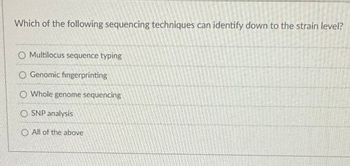
Human Heredity: Principles and Issues (MindTap Course List)
11th Edition
ISBN: 9781305251052
Author: Michael Cummings
Publisher: Cengage Learning
expand_more
expand_more
format_list_bulleted
Question

Transcribed Image Text:Which of the following sequencing techniques can identify down to the strain level?
O Multilocus sequence typing
Genomic fingerprinting
Whole genome sequencing
OSNP analysis
All of the above
Expert Solution
This question has been solved!
Explore an expertly crafted, step-by-step solution for a thorough understanding of key concepts.
Step by stepSolved in 2 steps

Knowledge Booster
Similar questions
- Which of the following best describes the process of DNA sequencing? a. DNA is separated on a gel, and the different bands are labeled with fluorescent nucleotides and scanned with a laser. b. A laser is used to fluorescently label the nucleotides present within the DNA, the DNA is run on a gel, and then the DNA is broken into fragments. c. Nucleotides are scanned with a laser and incorporated into the DNA that has been separated on a gel, and then the DNA is amplified with PCR. d. Fragments of DNA are produced in a reaction that labels them with any of four different fluorescent dyes, and the fragments then are run on a gel and scanned with a laser. e. DNA is broken down into its constituent nucleotides, and the nucleotides are then run on a gel and purified with a laser.arrow_forwardWhat is the most challenging issue facing genome sequencing? a. the inability to develop fast and accurate sequencing techniques b. the ethics of using information from genomes at the individual level c. the availability and stability of DNA d. all of the abovearrow_forwardDescribe two of the applications for genome mapping.arrow_forward
- Pedigree Analysis Is a Basic Method in Human Genetic: What does OMIM stand for? What kinds of information are in this database?arrow_forwardYou learned in the chapter that an STR locus is a locus where alleles differ in the number of copies of a short, tandemly repeated DNA sequence. PCR is used to determine the number of alleles present, as shown by the size of the DNA fragment amplified. In the Figure below are the results of PCR analysis for STR alleles at a locus where the repeat unit length is 9 bp, and alleles are known that have 5 to 11 copies of the repeat. Given the STR alleles present in the adults, state whether each of the four juveniles could or could not be an off-spring of those two adults. Explain your answers.arrow_forwardAn individuals set of unique _______ can be used in DNA profiling. a. DNA sequences b. short tandem repeats c. SNPs d. all of the abovearrow_forward
- Put the following tasks in the order they would occur during a DNA cloning experiment. a. using DNA ligase to seal DNA fragments into vectors b. using a probe to identify a clone in the library c. sequencing the DNA of the clone d. making a DNA library of clones e. cutting genomic DNA with restriction enzymesarrow_forwardMatch the method with the appropriate enzyme. _____ PCR a. Taq polymerase _____ cutting DNA b. DNA ligase _____ cDNA synthesis c. reverse transcriptase _____ DNA sequencing d. restriction enzyme _____ pasting DNA e. DNA polymerase (not Taq)arrow_forwardPCR can be used ______. a. as a cloning vector b. in DNA profiling c. to modify a human genomearrow_forward
- Cloning Genes Is a Multistep Process Which enzyme is responsible for covalently linking DNA strands together? a. DNA polymerase b. DNA ligase c. EcoRl d. restriction enzymes e. RNA polymerasearrow_forwardgenerated after a cDNA library is made unique sequences in the genome useful for mapping using sequence information all of the abovearrow_forwardFigure 17.7 You are working in a molecular biology lab and, unbeknownst to you, your lab partner left the foreign genomic DNA that you are planning to clone on the lab bench overnight instead of storing it in the freezer. As a result, it was degraded by nucleases, but still used in the experiment. The plasmid, on the other hand, is fine. What results would you expect from your molecular cloning experiment? There will be no colonies on the bacterial plate. There will be blue colonies only. There will be blue and white colonies. The will be white colonies only.arrow_forward
arrow_back_ios
SEE MORE QUESTIONS
arrow_forward_ios
Recommended textbooks for you
 Human Heredity: Principles and Issues (MindTap Co...BiologyISBN:9781305251052Author:Michael CummingsPublisher:Cengage Learning
Human Heredity: Principles and Issues (MindTap Co...BiologyISBN:9781305251052Author:Michael CummingsPublisher:Cengage Learning Biology Today and Tomorrow without Physiology (Mi...BiologyISBN:9781305117396Author:Cecie Starr, Christine Evers, Lisa StarrPublisher:Cengage Learning
Biology Today and Tomorrow without Physiology (Mi...BiologyISBN:9781305117396Author:Cecie Starr, Christine Evers, Lisa StarrPublisher:Cengage Learning Concepts of BiologyBiologyISBN:9781938168116Author:Samantha Fowler, Rebecca Roush, James WisePublisher:OpenStax College
Concepts of BiologyBiologyISBN:9781938168116Author:Samantha Fowler, Rebecca Roush, James WisePublisher:OpenStax College Biology: The Dynamic Science (MindTap Course List)BiologyISBN:9781305389892Author:Peter J. Russell, Paul E. Hertz, Beverly McMillanPublisher:Cengage Learning
Biology: The Dynamic Science (MindTap Course List)BiologyISBN:9781305389892Author:Peter J. Russell, Paul E. Hertz, Beverly McMillanPublisher:Cengage Learning
 Biology: The Unity and Diversity of Life (MindTap...BiologyISBN:9781305073951Author:Cecie Starr, Ralph Taggart, Christine Evers, Lisa StarrPublisher:Cengage Learning
Biology: The Unity and Diversity of Life (MindTap...BiologyISBN:9781305073951Author:Cecie Starr, Ralph Taggart, Christine Evers, Lisa StarrPublisher:Cengage Learning

Human Heredity: Principles and Issues (MindTap Co...
Biology
ISBN:9781305251052
Author:Michael Cummings
Publisher:Cengage Learning

Biology Today and Tomorrow without Physiology (Mi...
Biology
ISBN:9781305117396
Author:Cecie Starr, Christine Evers, Lisa Starr
Publisher:Cengage Learning

Concepts of Biology
Biology
ISBN:9781938168116
Author:Samantha Fowler, Rebecca Roush, James Wise
Publisher:OpenStax College

Biology: The Dynamic Science (MindTap Course List)
Biology
ISBN:9781305389892
Author:Peter J. Russell, Paul E. Hertz, Beverly McMillan
Publisher:Cengage Learning


Biology: The Unity and Diversity of Life (MindTap...
Biology
ISBN:9781305073951
Author:Cecie Starr, Ralph Taggart, Christine Evers, Lisa Starr
Publisher:Cengage Learning